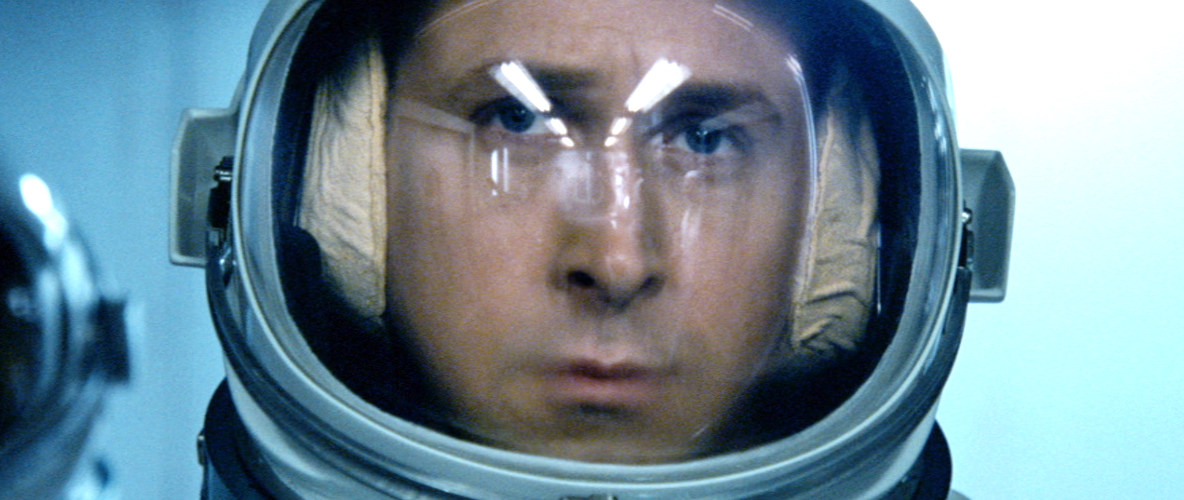The real dark side of the moon
The weight placed on one man for a remarkable journey is the subject of Damien Chazelle’s first film after the success of La La Land, and while he takes Ryan Gosling with him, he leaves behind the musical numbers and the tap dancing.
First Man is the story of Neil Armstrong and what it took to get the first men on the moon. That’s one thing to get clear in your mind going into this film though: it’s explored through Neil’s personal experience. How did he cope? How many people did he beat to be first out of that moon lander door? What impact did it have on his family? It’s explored here up close.
Gosling plays the titular first man as a muted and stunted character, set back early on by a family tragedy and he carries it throughout. This, apparently, would seem a reasonably accurate portrayal based on what’s been written about his life and it also seems to be in line with the way his family tell it. Chazelle might be chasing the Oscar he missed out on here, and while Gosling and Claire Foy (playing Neil’s wife, Janet) bolster this film, he might still have a wait on his hands.
Not that this film isn’t good. It manages to give you a little bit of insight into both the kind of man Neil Armstrong was (which, I’ll admit I knew little about) and also gives you an idea of how much of a struggle it was for NASA to get to the moon, losing countless men over many missions. Lip service is paid to political elements, such as Vietnam and where the money to fund a trip to the moon came from, and is the only part I feel could have been explored more. Beating the Russians is the main justification given to the mission, but this might have proven too wide a political avenue to explore (though it’s worth reading up about if you get the time). Again, it’s a film about the man himself and what made him tick more than the time or the political leanings.
The most telling element of the film comes in two parts: Neil’s rigid and serious answers to questions at a lighthearted press conference before the mission, juxtaposed with a family scene where Janet makes him sit the kids down to explain that he is leaving and may not come back (again, something his family have said happened). He uses the same defence mechanisms in both scenes, but clearly it isn’t what is needed in either situation – he’s a man trapped by his inability to express his emotions with people due to the events early in the film.
‘The sound design puts you up close with that rickety experience.’
As a study of the man, it may not be the most explosive watch, but it feels truthful and – if you’re genuinely interested in the subject of space flight – it can be incredibly tense. The first scene in which Neil pilots a craft which begins to bounce off the atmosphere reminded me of Interstellar‘s opening scene, but despite the fact they deal with man’s ability to explore space, these are two very different films in terms of scope.
Sound plays such an important part in the film and it has to, since much of what we see is close up, taking in what it must have been like to sit in a cramped capsule waiting for take-off on any given launch. We hear the creaking of metal, honking alarms and then at other times have complete silence as Neil learns of disasters over the phone or as a crew waits for radio contact. These were state-of-the-art ideas in the 60s, but it still amounted to shoving three blokes in a tin can and putting a rocket underneath them – the sound design puts you up close with that rickety experience.
Wider angles come later, when finally on the moon, and it’s testament to the direction taken in the filming of the mission that you still feel nervous despite the fact we know what the outcome is. We stay close with the crew, seeing less of the control centre. Those last few moments on the moon with Neil reveal a lot about him without much really happening. When he finally returns to Earth it is perhaps a gentle metaphor that Neil is kept behind a glass barrier when he’s visited by Janet.
It seems pretentious to say, but the moon itself is a character here. To begin with, it hangs over the testing of equipment and rockets, while one scene has Neil isolating himself from friends and family by studying the moon through a handheld telescope, a silent confidant, and later it poses a wide stillness to mirror the man we see as such a hero. Armstrong’s life was consumed by the goal of reaching the moon after joining NASA as he ran from confronting his emotions, while the moon itself consumes the screen towards the end.
What makes me sad about this film though – and it’s a slightly trivial aside – is that it highlights how little we’ve done as a species since 1969. Unable to sort out our petty squabbles, the only thing which spurs on advancement in science or exploration is when one nation threatens to embarrass another. There is a whole galaxy in which for us to play but we’re still toiling in the mud nearly half a century later.
